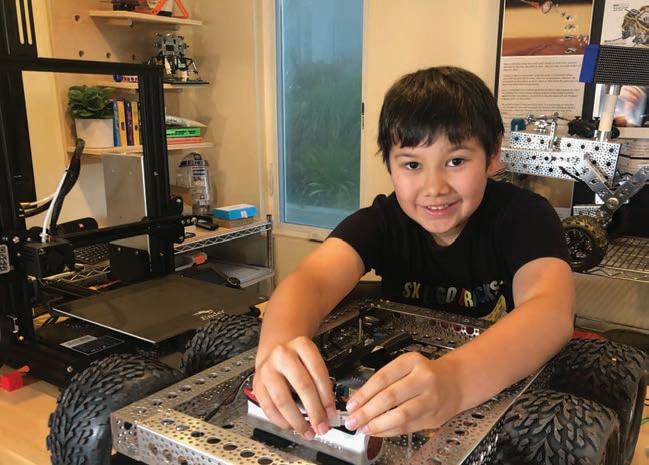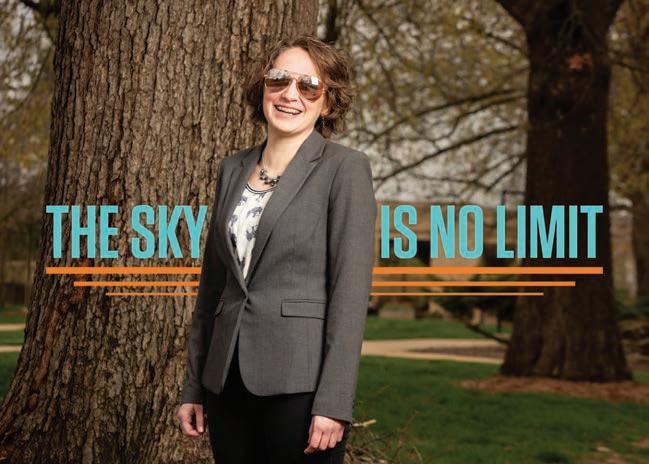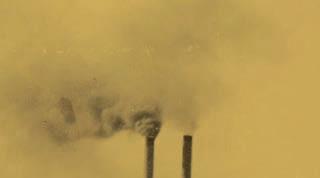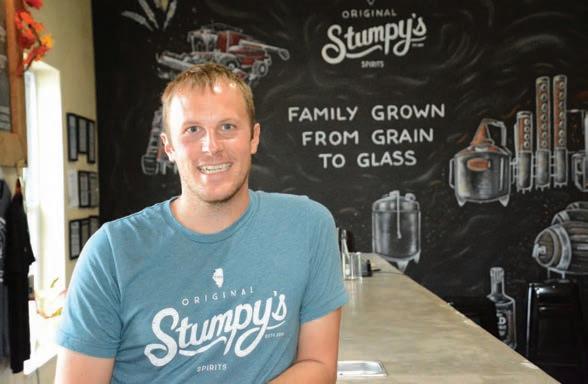
8 minute read
Campus rallies to 3-D print protective medical gear
from Missouri S&T Magazine, Summer 2020
by Missouri S&T Library and Learning Resources | Curtis Laws Wilson Library
When Phelps Health representatives anticipated a shortage of masks due to the coronavirus outbreak and needed help, S&T students, faculty and staff answered using technology and ingenuity.
Campus was abnormally quiet Saturday and Sunday, March 21–22, not only because it was the weekend before spring break, but also because, due to the coronavirus outbreak, most students had moved out for the semester and a majority of faculty and sta were preparing to work remotely. But 3-D printers in a couple of buildings on campus were humming away, fabricating prototype masks and face shield brackets.
Inside the Kummer Student Design Center, where S&T students usually work on rockets, solar cars, Mars rovers and other projects, a few students, faculty and sta outfitted one room with a dozen 3-D printers to produce prototypes for Phelps Health’s physicians, nurses and other medical workers.
Across campus, students at Missouri S&T’s Makerspace were using their 3-D printers to fabricate prototypes of the face shield brackets. ‘PHENOMENAL’ PROTOTYPES
e S&T prototypes “are phenomenal,” says Casey Burton, Chem’13, PhD Chem’17, director of medical research at Phelps Health.
Although there were no confirmed cases of COVID-19 in Rolla at the time, Burton and Shawn Hodges, Phelps Health’s director of ancillary and surgical services, foresaw the need to obtain more protective gear for the Rolla-based regional health system.
“Shawn had already been experimenting with 3-D printed masks with Rolla High School but realized he needed to drastically scale up production capacity to meet the needs of our community,” Burton says. “He reached out to me to rally the university and beyond for their support and to help organize those operations with him on our end.”
Burton asked S&T Chancellor Mo Dehghani if it was possible to harness the university’s 3-D printing capabilities to aid in the eort. Dehghani directed others across campus to do what they could to assist. e Kummer Student Design Center sta and students were among the first to respond. Chris Ramsay, MetE’83, MS MetE’85, assistant vice provost for student design and director of the center, marshalled the few remaining student members of the center’s 19 design teams to set up a 3-D printer farm to run 24 hours a day in the center at 10th Street and Bishop Avenue.
“We started out with five” 3-D printers at the design center, Ramsay says. “I sent a note out to all the design teams, and the students and alumni who were still in town brought their printers in and now we’re up to 12.”
STUDENTS RE-ENERGIZED
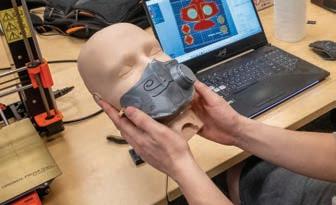

“ is has re-energized our design team students,” Ramsay says. Hundreds of S&T students had worked since the fall on projects for spring and summer design competitions that were canceled due to the coronavirus. “ is community need fulfills a hunger that they have to do something positive and meaningful in this crisis.”
While the design center produced prototype surgical masks, S&T’s Makerspace chief executive ocer Daustin Hoelscher, a senior computer engineering major from Mascoutah, Ill., was printing a prototype bracket for the face shields.
“ is was a game changer for us and even the rest of the world, so we appreciate Missouri S&T’s e orts,” says Dr. Brian Kriete, otolaryngologist and medical director of surgical services at Phelps Health.
“I’m so pleased with how our university community has come together to help in this time of need,” says Dehghani. “ e rapid response and support for one of our important community partners typifies the true S&T spirit of innovation, ingenuity and community engagement. I am very proud of the way our university has responded to this critical need.”
From design to delivery, S&T partnered with Phelps Health to fabricate face masks and shields for the hospital and first responders.

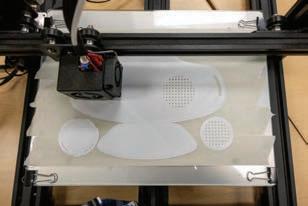
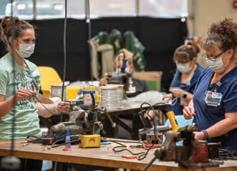
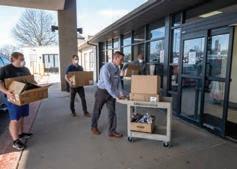
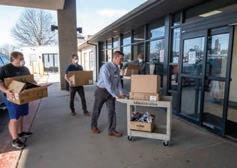

WHAT SOCIAL MEDIA CAN TELL US ABOUT COVID-19
FOOTBALL, SOCCER, VOLLEYBALL POSTPONED UNTIL SPRING
Because of the COVID-19 pandemic, the Great Lakes Valley Conference (GLVC) announced July 27 that it would postpone regular season competition and championships for the 2020 fall semester for the sports of football, volleyball and soccer. Competition in those sports, as well as GLVC championship events, will be conducted in the 2021 spring semester. e conference will allow competitions in cross country, golf, swimming, and track and field during the 2020 fall semester, and S&T will move forward with these sports. A decision about the start of basketball — which is scheduled to compete on a conference-only basis in the 2020–21 season — will be made by Oct. 1. e decision, voted on by the conference’s Council of Presidents, was made based on guidance from the athletics directors across the league and an extensive review of the recommended testing and safety measures developed by the NCAA Sport Science Institute.


People movement vs number of infections since March 6, captured July 14 from Kabir’s interactive website detailing the information he has collected from his analysis — mykabir.github.io
As COVID-19 swept across the U.S. and the world, people took to social media with concerns, questions and opinions. S&T researchers analyzed tens of millions of Twitter posts in real time to show the change in attitudes toward the disease.
Sanjay Madria, Curators’ Distinguished Professor of computer science, and Ph.D. student Yasin Kabir designed machine learning and natural language processing techniques for the study, which measured topics of concern, subjectivity, social distancing and public sentiment rather than predicting the spread of infection.
“We can see how people are reacting to news and ocials’ briefings about COVID-19. Are they comfortable, or are they more panicked?” Kabir says. “If we can understand that, we can help ocials know how to share news in a way that avoids panic.”
Kabir studied how public sentiment, trending topics and movement compared with the rate of infection. He learned that attitudes changed as the disease continued to spread.
“Early on, many people were skeptical of reports about the seriousness of the disease, and their sentiment was subjective rather than fact-based,” Madria says. “Slowly, they realized this is real, and their outlook became more fact-based.”
Geographical information in the analysis was limited to Twitter users who have enabled geotagging, which helped Kabir collect information by state and track movement between and among states.
Other researchers have developed models to predict the spread of COVID-19, Madria says, but this may be the only project that investigated social analytics for COVID-19 study.
“As we analyze trending topics, we can see how thinking and behavior change over time,” Kabir says. “at can help decision makers because they know how people are feeling.”
Ph.D. student Weixing Hao tests di erent materials. See more about their process online at rol.la/31cJh3Q.
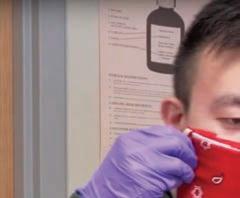
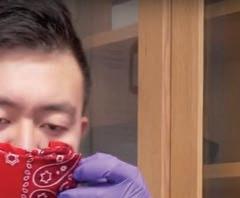
ENVIRONMENTAL ENGINEERS STUDY FACE-MASK MATERIALS
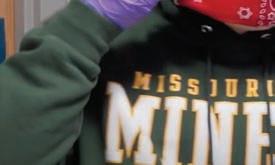
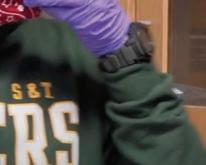

The day before the federal government issued new recommendations that Americans wear cloth face coverings to help slow the spread of the coronavirus, Yang Wang, a professor of environmental engineering who studies how fine particles like aerosols are transmitted, decided to test a few common household materials — pillowcases, scarves, furnace filters — “out of curiosity.”
His early results, which he shared on Twitter in April, attracted the interest of do-ityourselfers, fellow engineers and scientists, and the news media, including e New York Times and the Today Show.
After seeing posts on Twitter about whether scarves would suciently block aerosols, Wang decided to test a variety of household materials — including scarves, bandannas, pillowcases and household air filters — to see how well they might prevent the spread of aerosols.
Wang and his Ph.D. student, Weixing Hao, used a scanning mobility particle sizer, which measures particle size and concentration, then compared the “filtration eciency” of multiple layers of each material against aerosol particles ranging in size from a few nanometers to over 400 nanometers. ey found that layers of scarves and bandannas did a poor job of filtering out aerosols. Pillowcase fabric fared somewhat better, depending on thread count. e higher the thread count, the better the filter, the researchers determined.
But the best aerosol-blocking material of those Wang tested comes from commercially available household air filters. e multilayered air filters work almost as well as N95 medical masks to block aerosols, especially smaller particles, according to Wang’s initial findings.
As more layers of filter materials are stacked, however, a change in air flow through the materials, or “pressure drop,” becomes larger. is pressure drop increase can make it more dicult to breathe. Wang and his team are also looking for a combination of materials that produces the highest filtration eciency, but the lowest pressure drop. is o-the-cu study was more than just a passing curiosity for Wang, however. He is one of several S&T faculty, students and sta members who came together to help local physicians and medical sta by 3-D printing masks and face shields.
To protect health care workers adequately, these reusable masks require a filter to block airborne particles that may spread the coronavirus or other diseases. at’s where Wang comes in.
Wang and Hao continue to test dierent materials for the masks. While a furnace filter may be much more ecient at filtering out aerosols than a bandanna, its components could pose risks.
“ere are so many dierent types of fabric to consider,” says Wang, who recently won an international award for his research on aerosols. “Even for T-shirts, there are dierent types of materials. We plan to look at dierent types of pillowcases, bed sheets and other fabrics with dierent thread counts as part of the testing,” he adds.
“is is not a new field of study,” Wang says. “People in volcanic regions have studied the filtration qualities of various fabrics for years. I have received information about some of these studies. I find it all very helpful.”

